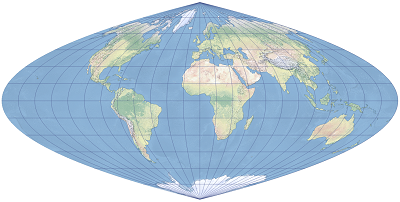Description
The Craster parabolic is an equal-area pseudocylindrical projection for world maps. The projection is similar to the sinusoidal projection except a meridian follows a section of a parabolic curve. The lateral meridians quite excessively bulge outward, producing considerable shape distortion at and near the map outline.
It was presented by John Evelyn Edmund Craster in 1929. It was independently developed by Reinholds V. Putniņš in 1934, therefore it is also known as Putniņš P4 projection. It is available in ArcGIS Pro 1.0 and later and in ArcGIS Desktop 8.1.1 and later.

Projection properties
The subsections below describe the Craster parabolic projection properties.
Graticule
The Craster parabolic projection is pseudocylindric. The equator and the central meridian are projected as straight lines, where the projected equator is two times as long as the central meridian. Other meridians are equally spaced parabolic curves, bulging away from the central meridian. The parallels are straight, unequally spaced, and perpendicular to the central meridian. Their spacing decreases very gradually as they move away from the equator. The poles are presented as points and appear as protruding edges. The map outline is similar to that of the sinusoidal projection. The graticule is symmetric across the equator and the central meridian.
Distortion
The Craster parabolic projection is an equal-area (equivalent) projection. Shapes, directions, angles, and distances are generally distorted. Scale is true along the 36°46ʹ north and south parallels and constant along every other latitude. Bulging meridians produce considerable distortion toward the edge of the projection and at high latitudes. Distortion values are symmetric across the equator and the central meridian.
Usage
The projection is appropriate for thematic world maps although its use is not advisable.
Limitations
Supported on spheres only. For an ellipsoid, the semimajor axis is used for the radius. The projection does not maintain areas when an ellipsoid is used.
Parameters
Craster parabolic parameters are as follows:
- False Easting
- False Northing
- Central Meridian
Sources
Snyder, J. P. (1993). Flattening the Earth. Two Thousand Years of Map Projections. Chicago and London: University of Chicago Press.
Snyder, J. P. and Voxland, P. M. (1989). An Album of Map Projections. U.S. Geological Survey Professional Paper 1453. Washington, DC: United States Government Printing Office.